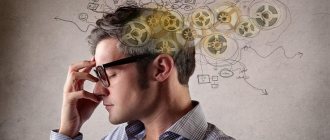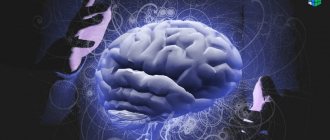|
Dear blog visitor!
I have prepared a gift for you - “Problem Solving Practices”, which will help you learn how to get answers to your questions and find the best way out of the current situation.
Pick up your gift using this link >>>
Good day, dear friends and visitors of the blog “Space of Inner Strength”! Today we will learn to enter an altered state of consciousness, or alpha state, and we will learn how to do this in 10 seconds. My record for entering the alpha state is 7 seconds, and into a deep state (2-3 seconds for relaxation, the same amount for entering a regular alpha and then a couple of seconds into a deep state of altered consciousness).
Then we will move on to practicing the theta state, although it is possible that you will fall into this state already in the first technique.
The alpha state of the brain allows you to quickly relax the body, enter into deep meditation, receive answers from the subconscious, and effectively reprogram destructive programs. In this state, it is recommended to work with visualizations, affirmations and other techniques.
To begin with, you just need to learn how to enter an altered state of consciousness, and then reduce this time to a minimum (10-15 seconds or less). I entered this state in 7 seconds when I was in a calm state.
I’ll tell you briefly about brain frequencies for those who don’t know what we’re talking about. Brain frequency is waves with a frequency of approximately 0.5 to 40 cycles per second, or 1.5 to 40 Hz. This frequency determines what state we are in: awake, drowsy or deep sleep.
The lower the frequency or less, the closer the person’s state becomes to sleep. The higher the frequency, the faster and more active our brain works.
Don't confuse brain frequency with human frequency. These are completely different systems.
Conventionally, brain frequencies were divided into 5 parts. The brain emits gamma, betta, alpha, theta and delta waves. Now let's take a closer look at each wave.
Gamma waves are the fastest. Their frequency is 30-45 Hz. These waves are generated by the brain in both hemispheres. Consciousness at this frequency works at its maximum. It is believed that these waves begin to be produced when a person needs to simultaneously work with different types of information and at the same time connect them with each other as quickly as possible. As gamma waves decrease, the ability to remember begins to decrease.
Betta waves are generated by the left hemisphere of the human brain. Their frequency is from 14 to 30 Hz. They are responsible for logical thinking, concentration, and decision making. Betta waves provide the opportunity to be active in society. They speed up brain function and enhance information processing and absorption. They also enhance the overall energy of the body, excite the nervous system, eliminate drowsiness and sharpen the senses.
Alpha waves. It is with them that we will work today. When you begin to relax with your eyes closed and various images begin to appear in your mind, your imagination begins to work actively and alpha waves appear. Their frequency is from 7 to 14 Hz. Alpha waves are generated by the right hemisphere of the brain.
When an adult is in a relaxed and comfortable state and at the same time retains conscious activity, a sufficient number of alpha waves are produced. Essentially, this is the state before falling asleep.
At this frequency, a person can effectively cope with the tasks assigned to him. Alpha waves greatly enhance the ability to perceive a large amount of information, develop abstract thinking, and help self-control. This frequency is also good for relieving stress, nervous tension and anxiety.
Alpha waves help connect the conscious mind with the subconscious mind (or soul). At this frequency, so-called joy hormones are produced, which help reduce pain and are responsible for a positive outlook on life, happiness, joy and relaxation.
Theta waves bring the body into a state of deep relaxation. This is a state of sleep where dreams can occur. Their frequency is from 4 to 7 Hz. If you master conscious entry into this frequency and conscious stay there, solving many issues will be much easier. I have not yet mastered this state. For now, alpha is enough for me.
In the theta rhythm after heavy exercise, the body can quickly recover. At this frequency, a feeling of bliss and peace appears. Theta waves are generated by the right hemisphere of the brain. They are the boundary between consciousness and subconscious.
Theta waves promote the manifestation of paranormal abilities. They enhance emotions and feelings, and also allow you to program and reprogram the subconscious, and get rid of negative and limiting thinking. For people involved in self-development, mastering this frequency can be of great benefit.
Delta waves. This rhythm begins to work during deep sleep. In the delta state, the body undergoes intensive self-healing and self-healing processes. Delta waves are generated by the right hemisphere of the brain. Their frequency is from 0.5 to 4 Hz.
An altered state of consciousness (ASC) begins with the alpha frequency and at the border of alpha and theta waves.
It is at these frequencies that it is good to reprogram the body. It would be ideal to work at theta frequencies, but this is actually sleep and requires long-term training.
Now we will learn to enter a deep alpha state without a computer and special music. In this state, you can recover in literally 10-15 minutes, find solutions to problems, get answers to troubling questions that you cannot get answers to in a normal state, reconfigure your entire body, reprogram internal programs and beliefs, and tune in to events.
Preparation for practice
You can enter the alpha state while sitting or lying down, whichever is more comfortable for you. If you fall asleep quickly in a relaxed state, this technique is best done while sitting. During your first training, before entering altered states of consciousness, you do not need to set any goals. To begin with, you just need to get good at walking into this state. Before class, we remove all irritating factors: turn off the phone, intercom, close the doors so that relatives do not disturb. Clothes should be loose. If extraneous sounds are still present, wear headphones.
A good time to do this technique is before bed, when everyone in the house is calm. The position should be comfortable; arms and legs should not be crossed.
Nostalgia
Nostalgia is a longing for a return to some past period or a seemingly incurable condition.
This is a reliving of the past, which is usually viewed in a more positive light than it might actually be. Research has shown that people with higher levels of nostalgia have higher self-esteem and are less likely to experience depression. Thinking about good memories for just 15 or 20 minutes a day will make you more alert than you were last week and happier than if you thought about your current life.
Nostalgia is a very powerful mood enhancer, so if you feel like you're a little scared, think about good memories of past times and you'll experience higher self-esteem and a more positive outlook on friendships and close relationships.
How to enter the alpha state - practice
We close our eyes and make the first count from 3 to 1 as follows. First, take a deep breath and, as you exhale, mentally pronounce the number 3 three times (three, three, three) and imagine the image of three in front of the inner screen. Let this image be the one that comes to you. Concentrate your attention on the number. At this time, you relax your body from head to toe.
If you don't know how to relax, first practice relaxing to the point where you can do it in a few seconds. I'm not writing about deep relaxation. Primary general relaxation is enough.
After this you need to lie down for a few seconds. Next, take a deep breath and as you exhale, say the number 2 three times (two, two, two). All the same. With number 2, you relax your face, cheeks, jaw, back of the head and eyelids. Notice the relaxation of the eyelids. Then lie down for a few seconds or a little longer, as you wish.
Then comes one. We also say the number 1 3 times, not forgetting about the image of the unit. Now we are not relaxing anything, but simply concentrating on one.
Then we lie down for a few seconds and begin the second countdown from 10 to 1. Now there is no need to take deep breaths and exhales. We do everything easily and relaxed. Let's start with ten. We also mentally pronounce the number 10 and imagine it. After 2-3 breaths while exhaling, we mentally pronounce the word “deeper” and mentally, as it were, fall into the depths, into something pleasant, like into a pillow.
Then we do the same with nine. We also mentally pronounce the word “deeper” and dive into the depths again. This is what we do with all numbers.
If at some number you start to get confused and forget what your score is, then you are already in alpha.
This can happen on any number. Once this has happened, there is no need to count anymore. Feel this state. There should be no active thoughts. If thoughts appear, just watch them as if from the outside and they will go away. A large flow of thoughts takes you out of a state of altered consciousness.
If you missed the alpha and fell asleep, it's okay. You just need to practice. If you didn’t get into this state the first time, you are in the state you will be in. It will still be alpha, just not deep.
The state of deep alpha is very pleasant, which is difficult to describe. This is a relaxed state with indescribable depth; it feels good and pleasant. When you get into deep alpha, you will understand this.
Stay in this state as long as you want. If time is limited, you can set an alarm clock with a pleasant melody.
In a normal alpha there is a period when you are overcome by love and happiness. Just observe this state and go deeper. If you want, you can remain in this state, but it is easy to slip through it, it is fleeting. For me, this state happens within a few seconds. Although this state of love may not exist, we are all different.
Sometimes 10-15 minutes in deep alpha can replace 1-2 hours of sleep.
In altered states of consciousness, various images may appear. Observe them and remain aware at the same time so as not to fall asleep. After some time, watching the images, it may dawn on you, you may understand something that you never understood, an interesting thought or idea may come to you, the necessary information that you have long forgotten may emerge in your memory.
Altered States of Consciousness: Wavelength Ranges
When we talk about an altered state of consciousness, we are primarily talking about a change in the frequency at which the brain operates.
Our brain can operate at frequencies from 0.5 to 40 Hz. It is this frequency that determines what state of consciousness we are in. The higher the frequency, the more active the brain works.
Gamma frequency
The brain works at a frequency of 30-45 Hz. Our brain moves to this frequency when we work with different types of information, connecting them with each other as quickly as possible. Gamma waves are generated by both hemispheres. At this frequency, consciousness operates at maximum speed. When the number of gamma waves begins to decrease, our ability to remember information decreases.
Beta frequency
The brain operates at a frequency from 14 to 30 Hz. Beta waves are active when we need to think logically, concentrate, make decisions, and contribute in society. These waves are generated by the left hemisphere and accelerate the work of the brain, increasing the speed and quality of processing and assimilation of information, enhance the overall energy of the body, excite the nervous system, sharpen the senses, and eliminate drowsiness.
Alpha frequency
The brain operates at a frequency from 7 to 14 Hz. This frequency turns on when a person is relaxed with his eyes closed, and various images can appear in the mind, actively including the imagination, since alpha waves are generated by the right hemisphere. It is a state of deep meditation in which conscious activity remains. We experience this state before falling asleep.
Alpha waves enhance a person’s ability to perceive a large amount of information, develop abstract thinking, and increase the efficiency of completing tasks. At the same time, alpha waves help to cope with stress, nervous tension, and anxiety, because hormones of pleasure and happiness (dopamine, serotonin, oxytocin, etc.) are produced at the alpha frequency.
Alpha waves connect consciousness with the subconscious, opening access to those parts of the subconscious that are not accessible when the brain operates at gamma and beta frequencies. In this state, answers to important questions, various insights, and creative ideas can come. At this frequency, you can replace negative attitudes and programs with positive ones. It is at this wavelength that it is most productive to work with visualizations and affirmations.
Theta frequency
The brain operates at a frequency of 4 to 7 Hz. When the brain operates at this frequency, our body is in a state of deep relaxation. This is a borderline state between consciousness and subconscious. Generated by the right hemisphere of the brain, they reveal superpowers in a person.
Conscious stay at theta frequencies launches the process of healing the body and resolving disturbing situations, giving a feeling of peace and bliss.
At theta frequencies, feelings and emotions are enhanced, and the body recovers faster after heavy exercise. Theta waves allow you to reprogram your consciousness and get rid of negative and limiting attitudes.
Many healers work specifically at theta frequencies.
Delta frequency
The brain operates at a frequency from 0.5 to 4 Hz. These waves are generated by the right hemisphere of the brain. This is the frequency of deep sleep, in which the body’s healing and restoration processes take place.
An altered state of consciousness is considered to be when the brain operates at alpha frequencies and a borderline state between alpha and theta waves.
Solving Problems Using the Alpha Brain State
In this trance state, you can tune in to solve the necessary problems and simply observe thoughts and images.
Once you learn to enter a deep alpha state, you can master problem solving through this technique. Before practice, tune in to solving the desired problem, otherwise you may not remember this in the alpha itself and immerse yourself in the alpha. If you have found a solution to the problem, immediately get out of this state, otherwise you may not remember later. With the help of an assistant, you can do great things, including writing books. To solve simple one-answer solutions, just enter alpha and observe what is happening there. We received an answer and left alpha.
If you need to receive a large amount of information, it is difficult to remember it. In this case, an assistant would be an ideal option. You received a piece of information in alpha, spoke it out loud and immediately entered alpha again. The assistant wrote down the information.
A new piece of information arrived, was spoken out loud again, the assistant wrote it down again, etc. Thus, you will practically not leave this trance state and dictate information to the assistant. Of course, you can also use a voice recorder for this.
It is very easy to get out of the alpha state. A little effort of will and you are already in betta. When leaving alpha, try to endure this wonderful state that you will have.
Thus, you will become stronger and happier, stress and problems will affect you less and less, you will become a more confident person. I prepared some fragments of texts on this blog using the alpha state.
Most people get into the first shallow alpha the first time. As I already wrote in the article about neural connections, it takes 21 days to create new skills. I recommend that you start practicing entering an altered state of consciousness for 21 days. Ideally, this should be done 3 times a day for 3 weeks.
When I started learning to enter a deep alpha state, I practiced 3 times a day and the day came when I entered deep alpha. I immediately felt this and, out of curiosity, looked at the calendar of my classes. And what do you think? It was 21 days of classes. This may be a coincidence, but it seems somewhat natural.
It is very pleasant to do this practice before bed. Of course, not everyone has the opportunity to enter this state 3 times a day. If you want to learn a new ability, look for conditions for practicing. Do this practice at least once a day, but daily. Once you have established this skill, daily practice will no longer be necessary. In order to enter an altered state of consciousness in 10 seconds, it took me about 2 months of daily practice.
Compassion
When we practice compassion, we accept a sympathetic awareness of the suffering of others along with a desire to alleviate it. When we experience compassion, we also realize the interdependence of all things. Compassion is the active choice to wish others relief from their suffering. It is the willingness to go beyond one's own interests for the benefit of others.
We let go of our own needs to care for the needs of others so that we can satisfy our deepest need: to feel connected to something. Feel like a part of all humanity.
Entering Theta
Very often, when entering alpha, a person falls into the theta state. With experience comes control of these states, but if the previous exercise is not enough for you, continue with this addition:
While in alpha, bring your attention to the tip of your chin and keep it there. This will move you to the theta frequency. At first this may take 5-10 minutes, but over time this time can be reduced to a few seconds. Instead of the chin, attention can be transferred to the third eye area.
Also a very good way to get into theta is to practice on awakening. Once you are awake, but not yet fully conscious and open your eyes, you are in the theta state. To remember this in the morning, you need to create the intention to remember it before falling asleep. When falling asleep, it is a very convenient moment to pass through this state and maintain it.
In order to make it much easier to enter an altered state of consciousness, you need to learn to feel your energy, your energy centers, and be able to manage your emotions. If you want to master these abilities, download the book “ The Reference State of the Chakras ” and you will discover a new interesting world within yourself.
| Author of the article, Lyubomir Borisov |
My page in VK >>> Instagram >>> YouTube channel >>>
.
Forgiveness
Forgiveness involves a feeling of unity with the one who has hurt us, and can be regressive or progressive. By accepting the feeling of forgiveness as something that can help us, we accept it as an aspect of acceptance, love, peace and truth, instead of experiencing hatred, emotionality, negativity, lies - all aspects of resentment.
Forgiveness brings complete peace. Resentment brings inner turmoil and suffering. Forgiveness means choosing to see absolute perfection and beauty in everything. Each and every person is currently operating at their own level of awareness or evolution.
I liked the article, subscribe to the most interesting and useful materials on the topic >>>
Dear visitor! I am constantly developing my abilities, experimenting with various techniques and practices.
If you want to know about these experiments, subscribe to the blog news. I share confidential information only with subscribers. Dear friends, I have prepared for you a practical guide, which includes dozens of the most effective techniques and practices for:
brain development, sensitivity to energies, solving health problems, gaining the skill of working with the energy of love, relieving psychological problems and mastering methods of changing fate.
All practices have been personally tested, and they have all shown to be highly effective!
Go to the practical guide page >>>
FIRST TIME ON THE BLOG? FIND THE INFORMATION YOU ARE INTERESTED BY THIS LINK >>>
Learn to control your destiny, make your dreams come true and achieve your goals in 30 days.
Dedication
When we are selfless, we focus on the needs of others rather than ourselves. It is the practice of selflessness and minimizing the satisfaction of ego needs and desires. To redefine life from selfishness to selflessness, focus on the well-being of others. This can be done in many ways. You can cleanse your life and give your fully healed body, heart, mind and soul to others by being in a relationship.
You may also be willing to share any amount of time that others need. Be happy in your life and in what others offer you.
Whenever you are confident that you are trying your best, you will get exactly what you need for maximum spiritual benefit.
ASC research methods
In the early 1980s, a research team led by Adolf Dittrich conducted a cross-cultural study of altered states of consciousness, for which a psychodiagnostic questionnaire for the severity of ASC was specially designed, initially in German, then in English with the name: Standardized Psychometric Assessment of Altered States of Consciousness
(1981), which has been translated into major European languages. Factorization of the questionnaire scales made it possible to identify three independent factors that describe ASC: the first is associated with changes in visual perception, the second is called “fear of personality disintegration,” and the third is associated with the experience of dissolution in the surrounding world and unity with nature and was called “oceanic feeling.”
Self-programming
Self-programming of a person consists of controlling one’s consciousness and correctly programming one’s subconscious.
- The task of consciousness is to explain to oneself the existing stereotypes of behavior, analyze one’s strengths and weaknesses, find and replace negative beliefs with positive attitudes.
- The task of the subconscious is to attract or create circumstances that correspond to the thoughts and images fixed in it, and to bring mental and other habits to automatism.
That is, it is almost impossible to change oneself with the power of thought alone; the desired result can be achieved only when new habits and attitudes are formed, and information about the new self is firmly rooted in the subconscious.
Forming a New Habit
We all know that to form a new habit, develop a skill, it is necessary:
- The thought of creating a new habit
- Consolidating thought with action
- Repeating an action multiple times
- Carrying out an action automatically - a habit has been developed
Why is this happening? How to reprogram the subconscious?
It turns out that reprogramming occurs not only at the level of thinking, but also at the emotional, and even at the physical, biological level.
Neuroplasticity and reaching a “new level”
Joe Dispenza talks well about what happens at the “brain level” when introducing new attitudes in his book “The Power of the Subconscious, or How to Change Your Life in 4 Weeks.”
Joe Dispenza, MD, is a neuroscientist who studies topics such as brain chemistry, neuroscience, memory formation, and life extension.
In this book he uses the term neuroplasticity. Neuroplasticity is the brain's ability to form new neural connections with the help of conscious intention and information from the environment. It is this ability of neurons that allows a person to achieve a new level of intelligence:
Neuroscientists call this process neuronal pruning and sprouting, but I describe the changes in terms of “learning” and “unlearning.” Neuroplasticity gives us the ability to transcend limitations and transcend the external and internal circumstances in our lives.
It turns out that we already have everything, all the tools to reach a new level, they are provided by nature. You just have to take it and do it - forget old habits and form new ones.
Headliner's main points
The headliner of the conference and the person declaring the trends for the coming year is traditionally Andrey Chernyshov (Chief Digital Officer, Densu Aegis Network Russia).
Andrey stated the topic of his report was “Natural Selection” and built the entire presentation on metaphors and associations of market development and natural selection in nature.
Signs
At the time of living in a state of altered consciousness, later referred to as ASC, a person experiences disturbances:
in the sense of time and chronology of events
He simply loses orientation in space, when a minute can seem like an hour, and an hour flies by like a second. For example, many people who became participants in a disaster, being in shock, cannot even approximately indicate how much time they spent at the scene of the incident. Or during the process of childbirth, a woman loses count of the hours spent in contractions and pushing.
in thinking
The archaic thinking that was characteristic of our ancestors becomes the leader. It lacks specificity and the ability to adequately perceive reality, sometimes confusing it with one’s own images and ideas.
in the ability to control oneself and one’s behavior
There is a fear of powerlessness and helplessness. A person feels that he is no longer subject to his own will, he is weak and vulnerable. Some people experience the opposite sensation of loss of control.
in body image
Depersonalization can make itself felt, that is, the loss of one’s own “I”; the personality seems to merge with space, being in a single process. Sometimes there is a separation of soul and body, or it seems that, say, arms or legs have increased in size, separated, etc.
in feelings
They experience feelings that cannot be expressed or designated in words. They are so subjective and unique that they have no name.
in perception
Hallucinations appear, and sometimes synesthesia is observed, that is, changes in sensory sensations when a person not only sees a color, but also hears it and tastes it. There are also such powerful changes in information processing that it seems as if one has learned the meaning of life or has been born again.
Deva Kingdom
To doubt God is to believe in him
The deva kingdom, on the contrary, develops through the senses. They evolve to become more advanced (in fact, to become human if they are sub-human devas), improving their ability to feel. They have an extremely sensitive perceptual apparatus with which they perceive reality. This allows them to experience the nature of material reality in a way that is not alien to us, but is not our way. The path of humanity is the path of development of the mind. To do this, you have to put your will into action, and only through conscious effort. This is the more difficult path. The path of the devas is comparatively easier; for them the path has no resistance at all.
We, humanity, are on the path of greatest resistance because we are working in the unknown. We are trying to develop from below that aspect which can only come from above. This requires striving, and it is the striving for the ideal that ensures development. We are developing - as long as we strive. Some may assume that after reaching a certain stage the urge will cease. But that's not true. Masters of Wisdom strive. When we think about aspiration, we tend to mean the desire: “I want to become better!” On the eve of the New Year's holiday, every time we make a promise to ourselves: in the new year to quit smoking, or drink less, and the like. Every year we make a list of such promises, and if we kept them, we would grow very quickly! But good intentions without their implementation do not bring us closer to the third Initiation. Good intentions are just symbols of the striving for an ideal that is necessary to move forward along the path of development of a real person. This advancement involves the Soul, in fact calls upon the Soul, whose nature is consciousness. We are what is a reflection of the SOUL. The soul sits on the throne of the heart, on the right side of the chest. We are never separated from our Soul.
Sharing is caring!
0 shared
- Tweet
Kinkhin
Kinhin or walking meditation is practiced in Zen schools between long sessions of sitting meditation. Kinkhin can also be practiced as a separate independent exercise for those who find it difficult to sit in a motionless position.
Depending on the school, the walking speed in kinhin may vary. Sometimes they take half a step in one breathing cycle, sometimes 10 steps. But the essence of walking meditation is the same: maximum conscious movements and full concentration of attention on breathing and the process of walking.
Stand straight, feet shoulder-width apart, weight distributed evenly. Relax your body to such an extent that there is no unnecessary tension, but at the same time be in a stable position. Place your palms at chest level. Imagine that you are being pulled up by a rope tied to the top of your head. This will help straighten your back and neck. Direct your gaze to the ground two meters away from you, without focusing on anything in particular. Relax your shoulders, arms, face. Start walking very slowly, one step per breath.
Focus all your attention on breathing and body movement. Just like in sitting meditation, allow your thoughts to flow freely, but keep most of your attention on your breathing.
When you are ready to end your practice, stop slowly, look up, and walk at a normal pace for a couple of minutes.
Story
History of the use of ISK
Altered states of consciousness could be used by people as early as 30,000 years ago. Mind-altering plants and/or excessive dancing were used to achieve an ecstatic or mystical state. Examples of early religious uses of altered states of consciousness are the rites of Dionysus and the Eleusinian Mysteries, as well as yoga and meditation. Followers of various shamanic traditions "enter altered states of consciousness to serve their community." Terence McKenna has suggested that the use of psychedelic mushrooms in prehistoric times led to "the evolution of human language and the use of symbols." Some theorists have suggested that mind-altering substances such as Soma may have contributed to the formation of some of the world's major religions.
Meditation in its various forms is being rediscovered by modern psychology because of its therapeutic potential and its ability to "calm the activity of the mind." In psychotherapy, methods such as hypnosis and meditation support psychological processes.
History of science and theoretical modeling
Due to the behaviorist paradigm in psychology, altered states of consciousness were rejected as an area of scientific research in the early 20th century. They were pathologized and viewed simply as symptoms of intoxication or demonic possession.
Their return to psychology began with William James's interest in various altered states, such as "mystical experiences and drug-induced states." James' research into first-person subjective experience contributed to the reconceptualization of self-reflection as a valuable research method in the academic community.
The social changes of the turbulent 1960s decisively led to a change in scientific perspective to the extent that introspection as a scientific method and ASC as valid areas of experience became more widely accepted. The foundations of the study were laid by various scientists such as Abraham Maslow, Walter N. Pahnke, Stanislav Grof and Charles Tart. They focused on the perceived beneficial aspects of ASCs, such as their potential to “promote creativity or treat addiction.” Rather, oppressive conditions such as detachment from trauma were ignored.
The results of Pahnke's famous Good Friday experiment suggest that mystical experiences may be induced by psilocybin. Later research by Rick Doblin found that participants rated these experiences as "spiritually high points in their lives."
At the height of the rise of the New Age subculture, Stanislav Grof and others formed the new field of transpersonal psychology, which emphasized "the importance of individual human experience, the validity of mystical and spiritual experience, the interconnectedness of the self with others, the world, and potential. self-transformation." Abraham Maslow's exploration of peak experiences as moments of "greatest happiness and satisfaction" further contributed to the depathologization of altered states.
Abraham Maslow's exploration of peak experiences as moments of “greatest happiness and satisfaction” further contributed to the depathologization of altered states.
The first summary of the existing literature was performed by Charles T. Tart in his book Altered States of Consciousness
, leading to more widespread use of the term. Tart introduced the key terms “discrete” and “basic state of consciousness” and thought about a general classification system for ASC. He also called for “state-specific sciences,” in which researchers should pursue ASC science from within those states.









